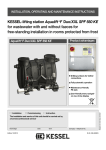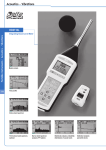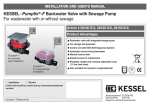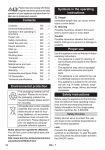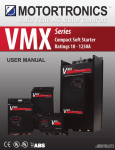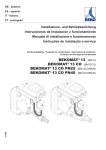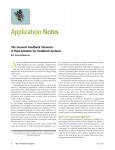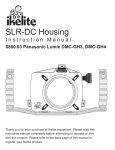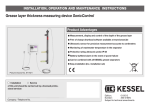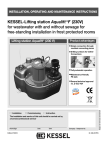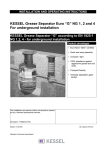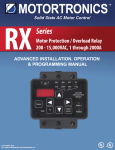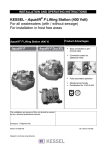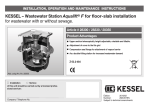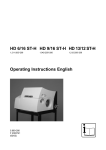Download KESSEL-lifting station Aqualift F (400V) Comfort for wastewater with
Transcript
INSTALLATION, OPERATION AND MAINTENANCE INSTRUCTIONS KESSEL-lifting station Aqualift F (400V) Comfort for wastewater with and without sewage for free-standing installation in frost free rooms Aqualift F Aqualift F Duo/XXL Product Advantages Additional inlet connections possible Fully automatic operation Maintenance-friendly PE-tank Installation Service of this unit should be carried out by a licensed professional servicer: Company / Telephone number Edition 2012/05 Date Town subject to technical amendments User friendly 6-line digital display Number 206-829EN 1. Safety Information General safety precautions During installation, operation, maintenance or repairs to the system, please observe the accident prevention regulations, the applicable DIN and VDE standards and guidelines, and also the regulations of the local energy and supply companies. The systems may not be operated in explosive areas Electrical hazards This system contains electrical voltages and controls rotating mechanical parts. Non-observation of the operating instructions could lead to serious damage, injury or even fatal accidents. The system must be securely disconnected from the mains supply before commencing any work on it. The local master switch and the cut-outs must be turned off, i.e. switch the system to zero-potential and take precautions to ensure it cannot be switched on again. If only cut-outs are available, these must be switched off and a sign attached to prevent third parties from switching the main fuse on again. VDE 0100 applies to all electrical work on the system. The control unit and the level control are under voltage and may not be opened. Only electricians may work on the electrical equipment. The term 'electrician' is defined in the VDE 0105. Steps must be taken to ensure that the electrical cables and all other electrical system parts are in a fully functional condition. If any parts are damaged, the system may not be operated and/or must be immediately shut down. Risk of burning fingers and hands The motor may become very hot during operation Risk of injury to fingers and hands The pumps are equipped with a closed impeller. Therefore work on the pump may only be carried out if the power supply has been disconnected and the rotating parts have stopped rotating. Take care on sharp edges during maintenance or repair work. Risk due to heavy weights The lifting system models with one pump weigh around 45 kg, and with two pumps around 84 kg. The systems may only be lifted or mounted by two persons with appropriate care wearing protective equipment (e.g. protective shoes). The pumps may only be removed slowly or placed in the pump flange opening by two persons (if suitable precautions to prevent slipping have been taken). 2 1. Safety Information Health risk The wastewater system transports wastewater that contains faeces; in turn this faeces may contain harmful substances. Whenever working on the system, always ensure that there is no direct contact between the wastewater and/or soiled system parts and your eyes, mouth or skin. In the event of direct contact, clean the affected part of your body thoroughly and disinfect if necessary. It is also possible that the atmosphere in the tank may be harmful. Therefore before opening the cleaning aperture (or removing the pump) ensure that the respective room is adequately ventilated or provide for (forced) ventilation during the opening process. Noise issues When the pump is operated, a noise level is created that may be a nuisance depending on how the pump is installed. If there are maximum noise level stipulations that need to be observed, appropriate measures need to be taken. The sound damping set from KESSEL may also be helpful here. Risk of explosion The inside of the tank is considered to be explosive within the meaning of EN 12050 because the biological digestive process may create flammable gases (hydrogen sulphide, methane gas). Therefore, when unscrewing the pump or the cleaning aperture lid or any other parts, ensure that the room is adequately ventilated or provide for (forced) ventilation during the opening process. Whilst the tank is open, it is forbidden to smoke or carry out any other activities in the respective room that could cause the gas to ignite (e.g. operation of electrical devices without encapsulated motors, metalworking etc.). 3 Table of contents 1. Safety information ...........................................................................................................Page 2 2.2 5 2. General 2.1 Area of application...............................................................Page 3. Technical data 3.1 Aqualift F Duo XXL ..............................................................Page 3.2 5. Electrical connections 9 4.1 Fitting the collecting tank ....................................................Page 11 4.3 Setting the pressure level switches ....................................Page 13 4.2 5.1 5.2 5.4 6.1 6.2 6.3 6.4 7. Inspection and maintenance 7.1 7.2 7.3 8. Malfunctions and troubleshooting 9. Control unit 8 Instructions for safe use in hazardous areas ..................Page 5.3 6. Initial operation Aqualift F Duo 1,1 kW; 2,2 kW.............................................Page 6 3.3 3.4 4. Installation and assembly System description .............................................................Page 5 8.1 8.2 9.1 Electric switch unit ...............................................................Page 10 Connecting the pipes...........................................................Page 11 General notes...................................................................... Page 14 Installation of the switch unit................................................Page 14 Installation, wiring ................................................................Page 14 Control of the flow-direction ................................................Page 16 General notes ......................................................................Page 16 Pressure outlet connecting pieces.......................................Page 16 Functional description..........................................................Page 16 Functional test ....................................................................Page 18 Notes on the pump .............................................................Page 21 Notes on aeration device.....................................................Page 21 Notes on the electrical switch unit ......................................Page 22 General malfunctions ..........................................................Page 23 Malfunction messages.........................................................Page 24 Switch unit ...........................................................................Page 28 10. Spare parts and accessories 10.1 11. Warranty ...........................................................................................................Page 35 12. Declaration of conformity 13. Handover certificate 10.2 Accessory parts ...................................................................Page 30 Spare parts ..........................................................................Page 31 ...........................................................................................................Page 36 ...........................................................................................................Page 38 4 2. General 2.1 Area of application The lifting stations pump wastewater with and without sewage that occurs below the sewer and backwater level fully automatically into the sewage system in accordance with the requirements of DIN 1986. They are only suitable for use for domestic wastewater, for example in single family and multifamily homes, business, hotels and restaurants, department stores, hospitals, schools or similar cases. If the feed to the lifting stations must not be interrupted during normal operation, the lifting station must be equipped with a second pumping device of the same capacity which switches on immediately when required (twin station instead of single station). The KESSEL lifting station Aqualift® F has been designed for free-standing set-up in frost-protected rooms. The respective switch unit must be installed in a flood-proof, dry and frostprotected room. The wastewater submersible pumps are equipped with a single-channel impeller and have a completely free passage of 40 mm. The pressure pipes must be at least of the size DN 80, the ventilation pipes at least DN 70. Wearing media must be kept away from the pump impeller. The systems are suitable for constant wastewater temperatures up to 35°C. A maximum temperature of 60°C is permissible briefly (up to 10 minutes). 2.2 System description 2.2.1 Aqualift F 1,1 kW/2,2 kW The KESSELpumping station Aqualift® F as a single or twin system basically comprises the following assemblies: 1.8 1.3 1.5 1.4 1.6 1.2 1.7 1.1 1.4 1.6 1.9 1.2 5 1.5 1.8 1.1 1. Collecting tank made of PEHD gas and watertight, with 1.1 One or two wastewater pumps, each of which has a 5 m connection cable 1.2 Pneumatic level control with 5 m air hose each 1.3 Cleaning opening 1.4 Connection for DN 100 inlet pipe 1.5 Connection for DN 70 ventilation pipe 1.6 Connection for manual diaphragm pump DN 32 / 40mm diameter 1.7 DN 100 pressure outlet connecting pieces with integrated backwater flap and aerating device 1.8 Drilling areas 1.3 2. 1.7 Electric Control Unit (see illustrations in chapter 8) 3. Accessories (not illustrated) 3.1 Brackets with screws and dowels for fixing the tank to the floor 3.2 Rubber hose with hose clamps for the pressure pipe connection 3.3 Sound-insulating underlay mat Mono: Art. no. 28692 Duo: Art. no. 28693 A detailed description of the system set-up can be found in chapter 10, Spare parts. 2. General 3. Technical Data 2.2.2 Aqualift F Duo XXL ➅ ➀ ➅ ➁ ➂ ➄ ➆ ➃ ➀ DN 150 inlet ➁ DN 100 pressure outlet ➂ DN 100 ventilation connection ➃ Twin wastewater pumps each with 5 meter power supply cable ➄ Polyethylene collection tank ➅ Cleanout / Maintenance access ➆ Closure valve ➇ Non-return flap ➆ ➇ ➃ ➇ 2400 Versions: Aqualift F Duo XXL (twin pumping system) 3.3 kW with DN 100 outlet, order number 28638 Aqualift F Duo XXL (twin pumping system) 4.2 kW with DN 100 outlet, order number 28639 Aqualift F Duo XXL (twin pumping system) 5.6 kW with DN 100 outlet, order number 28640 3.1 Aqualift F Duo XXL Max. Förderhöhe H (m) Performance Curve Aqualift ® F Duo XXL 22 20 18 16 14 12 10 8 6 4 2 0 Q min nach DIN EN 12056-4 für DN 100 400 V 3,3 kW 400 V 4,0 kW 400 V 5,6 kW 0 10 20 30 Max. Fördermenge Q (m³/h) 0 5 Max. Fördermenge Q (l/s) 40 10 Type Nominal capacity (P2) Rated capacity (P1) Operating voltage Rated frequency Nominal current Connection cable Temperature of pumping medium Weight (pump) Protection Class rating Operating mode Sound level Fusing 50 60 15 70 80 20 400 V - 3,3 kW 2,6 kW 3,3 kW 400 V DS 50 Hz 6,4 A 5 m long, 7 x 1,5 mm 40 °C 30 kg IP 68 (24 h /3 mWs) S2 30 Min. < 80 db 3 x16 A 90 100 25 2 400 V - 4,2 kW 3,5 kW 3,3 kW 400 V DS 50 Hz 7,9 A 5 m long, 7 x 1,5 mm 40 °C IP 68 (24 h /3 mWs) S2 50 Min. < 80 db 3 x 20 A Characteristic C 6 2 400 V - 5,6 kW 4,8 kW 3,3 kW 400 V DS 50 Hz 10,2 A 5 m long, 7 x 1,5 mm 40 °C 31 kg IP 68 (24 h /3 mWs) S2 30 Min. < 80 db 3 x 25 A 2 3. Technical Data 3.2 Aqualift F 1,1 kW/2,2kW • Aqualift F Duo (twin pump system) 1.1 kW / 2.2 kW with DN 100 pressure outlet Ø110 DN70 Ø75 Ø40 160 DN32 Zulaufhöhe 300 539 780 Ø110 Ø110 DN100 DN100 DN100 773 • Aqualift F Mono (single pump system) 1.1 kW / 2.2 kW with DN 100 pressure outlet DN100 DN70 Ø75 Ø40 DN32 154 Zulaufhöhe 180 525 475 Ø110 DN100 Ø110 564 7 3. Technical Data Type Nominal capacity (P2) 400 V - 1,1 kW 400 V - 2,2 kW 1,6 kW 3,1 kW 1,15 kW Rated capacity (P1) Operating voltage Rated frequency Nominal current 14,4 A Fuse Connection cable 50 Hz 5,4 A 30,8 A 3 x 16 A Charakteristik C 5 m long, 7 x 1,5 mm2 Temperature of material pumped Weight (pump) 30 kg Protective rating Sound level 400 V DS 3,2 A Start-up current Operating mode 2,4 kW S1 35 °C Max. period of perm. operation 240 Min. < 70 db Pump volume Table 2 31 kg IP 68 ( 24h; 3m WS) 20 l (Mono); 50 l (Duo) S3 30% duty cycler < 70 db Performance chart Q min DIN 1986 (vmin = 0,7m/s) for DN 80 Q min DIN 1986 for DN 100 Pumping height m 15 14 13 12 11 10 9 8 7 6 5 4 3 2 1 0 0 4 230 V 1,1 kW 400 V 2,2 kW 400 V 1,1 kW 8 12 16 20 24 28 32 36 40 44 46 48 50 52 54 56 58 pumping Q (m 3 / h) 8 3. Technical Data 3.3 Instruction for proper safe use in explosion endangered areas Twin Pumping System Pump control units are available for single pump as well as twin pump systems. Pump activation is controlled by a pressure sensor. The control unit should not be installed in an area that is designated as an explosion risk. MTL 7789+ Protection Appropriate use Classification: II (1) GD [EEx is] IIC (Group II, Category (2)G, additional operating parts for gaseous atmospheres) The requirements of EN 50014:1997 + A1 – A2, EN 50020:2002 have been fulfilled. EC-type examination certificate of the Zener BAS 01 ATEX 7217 Description II(1) G (EEx ia) IIC CE 1180 Ta = -20 deg C - +60 deg C Operational Manual Installation / Commissioning This wastewater pumping system may only be installed, connection and commissioning by a licensed professional. People operating this system must have knowledge of regulations and codes concerning pumping systems operated in explosion risk areas. Check to insure that the classification of this system (see identification plate on pumping system) meets the on-site requirements. Allowable operation temperature range of system : 0 dec C to +50 dec C 9 Circuit ignition protection EEx ia IIC Connection jacks (OFF, ON1, ON2, ALARM) Maximum values: Uo = 28 V Io = 93 mA Ro= 300 Ω Po = 0,33 W Co = 0,083 µF Lo = 16 mH Lo / Ro= 106 µH / Ω Installation instructions • Please follow all local and national safety regulations • Please also follow this installation and operational manual Special requirements for safe operation of this system None Maintenance / Servicing • Opening the control unit cover reduces the protection class (watertightness). Before opening the control unit cover make sure that moisture or splash risk in the area will not effect the control unit. If moisture or splashing could be a risk, make sure to disconnect the control unit from its power source before opening the cover. In general, no moisture, fluids or dirt should ever enter the interior of the control unit. Only a licensed repairman should open the control unit cover • After any control unit work has taken place, the control unit cover should be closed and properly secured so that the protection class of the control unit is assured. • No changes to the control unit should be made. Repairs on the control unit are not possible. In the case of a problem with the control unit, please contact the manufacturer. • If required, system information such as the user’s manual, EC Conformity Declarations and other system relevant information can be obtained from the manufacturer. 3. Technical Data CAUTION! When power switch OFF, power still supplied to unit! 3.4 Electrical Control Unit 3.4.1 General technical data Ambient conditions Permissible temperature range: Permissible air humidity: non-condensing Maximum operating height: Power consumption max. ca.5 VA for single (electronics without motor) Protective class Protective rating 0 to 50 °C 10 to 80 % 2000 m above sea level Class 1 IP 54 when fitted correctly 3.4.2 Supply Mains supply PE/N/L1/L2/L3 according to marking on terminal block for single / twin system Relay ‘Warning’ Switcher, opener, middle contact, closer each with max 42 V ac/dc 0.5 Amp. Motor (single system) Motor PE Mains connection (spring connection on board) Motor U T1 contactor Motor V T2 contactor Motor W T3 contactor Motor 1/2 (twin system) Motor 1/2 PE mains connection (spring connection on board) Motor 1/2 U T1 contactor 1/2 Motor 1/2 V T2 contactor 1/2 Motor 1/2 W T3 contactor 1/2 Operating voltage 400 / 230 V 3~ 50 Hz ± 10% rotary current (L1=230V AC / 50Hz±10%for supplying the power packs for the electronics) Pre-fuse required For fusing information see Page 6 Table 1 and Page 8 Table 2 3.4.3 Inputs - Each pump has the circuit TF1 - TF2 is bridged (do not remove bridge) - Pressure sensor with pressure tube 6 x 4 mm. - Pressure sensor incoming approx 24 Vda < 5 mA (not ATEX) - Pressure sensor incoming (with ATEX) (with XXL Systems) 3.4.4 Outputs "Malfunction" relay Switcher; opener, middle contact, closer each with max 42 V ac/dc 0.5A for ‘malfunction’ and ‘warning’ relay; external power should be separately fused 10 } } max. 4kW max. 4kW 4. Installation and assembly The following parts are included in the scope of supply (see section 2.2): - Collecting tank with all components mounted - Electric switch unit - Accessory parts IMPORTANT: The electric switch unit must be stored frost-free and dry. If the system is not connected directly to the power supply on installation, the switch unit inc. all electric parts must be stored accordingly. CAUTION: Hazard through heavy weights. The lifting stations weigh approx. 45 kg (single system) and approx 84 kg (twin system). The parts may only be lifted and/or assembled using suitable equipment and exercising appropriate caution. If the systems are dropped, this can lead to irreparable damage to the system parts (e.g. pump) or the whole system. Such damage is not covered by the warranty. Site of Installation The KESSEL Aqualift F wastewater lifting station is designed for free standing installation in a frost protected room. The included control unit should be installed in a dry, frost free and flood protected area. 4.1 Fitting the collecting tank Maintenance work on the lifting stations, they must always be installed in such a way that there is sufficient access to all areas of the lifting station and replacement of all components is guaranteed. According to DIN 12056, there must be at least 60 cm space all round the system (on all sides and above it) to meet this requirement. The system must be set up at the appropriate spot in the room, aligned horizontally and placed on practical soundinsulating material (available as an accessory from KESSEL). The brackets, screws and dowels must be used to fix the liftingstation to the floor to prevent movement or twisting. INSTALLATION SITE: The KESSEL lifting stationAqualift® F has been designed for free-standing set-up in frost-protected rooms. The respective switch unit must be installed in a flood-proof, dry and frost-protected room. 4.2 Pipe connections All pipes must be routed so that they drain freely with gravity. All pipe connections must be flexible and sound insulated. There are two types of connections possible: I. Use of existing preformed inlets on the pump body (for connection of inlet pipe, ventilation and manual diaphragm pump according to Fig.Aand B) by cutting off the "front cap" as shown in Fig. C. Ventilation DN 70 (OD=75mm) connection DN 100 Manual diaphragm connection DN 32 (OD=40mm) OD=110mm Illustration A: Single Pump System Ventilation DN 70 (OD=75mm) Inlet connection DN 100 (OD=110mm) Attachment bracket Tank-lifting station Manual diaphragm connection DN 32 (OD=40mm) Floor mounting Illustration B: Twin Pump System Insulation mat (optional) Floor 11 4. Installation and assembly A standard plastic pipe with gasketed socket can be pushed over the inlet connection on the pump body (see Illustration C). Pipe connection Alternatively, the connection of a plastic pipe with DN 100 for the inlet or DN 70 for ventilation can be carried out using connection clamps or rubber connection couplings. To prevent damage to the pipe when tightening clamps or coupling screws, a steel re-enforcement ring should be placed inside the inlet connection (see Illustration D.) Hose Clamps Transition hose Saw the clip Saw off closed inlet Support ring Inlet connection Tank-lifting station Hose Clamps ill. D: II. Connecting pipes to drilled out additional inlet holes on side of pump body (for inlet pipe or manual diaphragm pipe connection) using hole saw. Appropriate pipe inlet gasket should be fit into previously cut out inlet hole, interior portion of gasket should be lubricated and then pipe should be push fit (see Illustration. E) Attachment bracket Pipe connection Hole drilled ill. C: Tank-lifting station ill. E * KESSEL-Accessory parts 12 4. Installation and assembly IMPORTANT In the case of all the connections drilled at the side it must be remembered that the level control is adjusted in such a way that during normal operation the water level in the container only reaches up to or just below the lower edge of the moulded inlet pipe connecting piece on the side. For this reason, a respective water level will result in all pipes that are connected lower down. In the case of inlet pipes this means that dirt deposits cannot be excluded and may lead to the pipe becoming blocked in extreme situations. l Inlet pipe The inlet pipe must be laid with a downward slope / gradient to the KESSEL lifting station in accordance with DIN 1986 and be routed as straight as possible. Connection to the tank can be carried out as described in Section I or II above. The ventilation pipe sets up pressure compensation to the fresh air for the air flowing into or out of the system during emptying or filling. According to DIN 1986 the size of the ventilation pipe must be at a minimum DN 50 for these lifting stations and must be routed over the roof to avoid odour problems. Connection to the tank can be carried out as described in Section I or II above. l Pressure pipe The pressure pipe for directing the soiled water into the sewage system must be connected directly to the respective pressure pipe connection. According to the regulations of EN 12056, the outlet pressure pipe must layed above the backwater level and connected to a ventilated drainage pipe. The rubber hose included in the scope must be pushed about 4 cm over the pressure connecting piece at the pressure connection and fixed in place using a hose clamp as a means of acoustic insulation and to prevent transmission of forces. Connection of the rubber hose is not an interlocking connection. It must be set up on site using brackets. The pressure pipe must be connected (see above) in such a way that no forces are transferred to the system and there is no direct contact with the building (structure-borne noise). No other drainage fixtures may be connected to the pressure pipe. Air-tightness and material strength must be guaranteed under pressure load, too. This must be checked during initial operation. The pressure pipe must have a flexible connection to the building to prevent water hammer forces from being transferred to the builiding. When cast metal or steel pressure pipes with low absorption properties are used, a water hammer arrestor must be included in the pressure pipe from pumping heights from 5 m. Pressure resistant non-return flaps available as accessories: DN 80 backwater flap made of cast iron (art. no.: 206-199) 13 DN 100 backwater flap made of cast iron (art. no.: 206-198) Aerating device (art. no. 206-200) A shut-off valve must be installed in the pressure pipe on site in accordance with EN 12056. For this, we recommend the non-return valves for mono systems (art. no. 28683) and for duo systems (art. no. 28694) from the KESSEL range of accessories. 4.3. Level measurement Level measurement takes place using a pressure sensor and submersible pipe. The transparent air hose must always be routed rising to the switch unit so that no condensation can collect in the air hose. Perfect function is only guaranteed when permanent pressure compensation takes place between the switch unit and lifting station. Excess air hose lengths must be shortened. The switching levels are pre-set and can be changed using the switch unit. More detailed information is available from KESSEL Customer Services. l Aqualift F XXL Models Float switch settings Float switches on the Aqualift F XXL lifting stations have been installed and set at the factory. Do not attempt to change the location or level of these float switches as it will only lead to problems with the operation of the lifting station. Four float switches are included in the XXL lifting stations (pump off, pump 1 on, pump 2 on and alarm). The alarm level is approximately the same height as the inlet level of the lifting station. In the case that different activation levels are required, the float switches need to be adjusted accordingly. It is important that the alarm level float switch activation level is not set higher than the base of the inlet level and also that the Off float switch is not set too low to prevent the pump from pumping too low and intaking air. 5. Electrical connections Attention: Only qualified electricians may carry out the work on electrical equipment described below. Before any work is carried out on the control unit, the pump or level control, the main power supply to the lifting station must be turned off and fuses must be switched off, i.e. be voltage-free and secured against being accidentally re-activated during service work. 5.1 General instructions An external main switch must be installed for the electric switch unit that can be used in an emergency to switch off all the downstream circuits independently of the control unit. This must be assigned clearly to the switch unit. All connected cables must be strain-relieved. Screw connections not used must always be sealed properly. IMPORTANT: All the cables connected to the electrical switch unit must be fixed in place using suitable measures (e.g. cable ties) so that they do not cause a hazard in the 1-error case, i.e. if a connection becomes loose. 5.2 Mounting the switch unit Screw the housing cover with max. 1 Nm. Install the switch unit provided in a frost-free, dry, flood-proof and well-ventilated room. The switch unit has been designed for vertical wall-mounting on a solid base. Sufficient air circulation in the room of installation must be insured to prevent excessive temperatures. The unit is mounted using 4 screws (Ø 6 mm) at the corners of the housing (drilling template in the packaging box). The mounting holes are accessible after the cover has been fully opened. 5.3 Installation, wiring The pump cable and pressure sensor cables have a standard length of 5 m. The pump cable may be extended by using a VDE certified extension connection. In the case that the pressure sensor cable is to be extended, the extension connection must be completely air right and the cable must be run in a positive slope from the lifting station to the control unit (no loops or kinks). Please heed national and local safety regulations. If these are not observed, personal hazard may be the result. In addition, no liability or warranty will be granted. After work has been completed, the housing cover must be sealed properly again. In the case that the lifting station has a pressure sensor, the cable for this sensor should be laid separately from the power cable and the pump cable in order to insure proper operation of the pressure sensor. 14 5. Electrical connections The individual connection jobs are listed in the following table and in the connection diagrams on pages 27 and 29. The explanations in chapter 8, Electric switch unit, must also be heeded (position of the control elements, view of the inside of the switch unit). SINGLE PUMP LIFTING SATION – please follow all safety instructions and regulations! Work to be completed Description Battery connection Mains connection Motor power cable Motor temperature sensor Level measurement Outputs "Malfunction" and "alarm / warning" • Both batteries (2 x 9V) must be connected on the board. • Connect the mains supply cable L1 / L2 / L3 / N / PE at the terminal block using screw connection. • N and PE always have to be connected. • The required fusing must not exceed 16 Amps for each phase. • An improper connection (Phase and N improperly connected for example) will activate the integrated fuse (315 mAT) • Connect the motor supply cable U/V/W to the connector in the right direction in the lower screw terminals T1 / T2 / T3. The direction of rotation of the motor must be heeded. • PE must be connected with TF1 and TF2 to the terminal block on the board underneath the motor protection switch. • Wire 4 of the motor power cable must be connected to the lowest terminal of the terminal block TF2-TF1. Wire 5 of the motor power cable must be connected to the middle terminal of the terminal block TF2 TF1. The input TF2 is bridged with a 2-pole jumper, i.e. the middle terminal is double occupied. Jumper must not be removed! Connection to the pressure sensor The transparent air hose must always be laid with a positive slope to the control unit (no loops or kinks in the cable). The connection of the air sensing hose to the control unit must be firmly and properly connected. • The "malfunction" and "warning" messages are issued via a relay (changeover contact) without protective circuit. Inductive loads must be dejammed externally. The quiescent state (currentless) of the relays is printed on the circuit board. It means "malfunction" and "warning" message is switched on. • 42 V DC/ 0.5 A 15 5. Electrical connections TWIN PUMP LIFTING SATION – please follow all safety instructions and regulations! Work to be completed Description Battery connection Mains connection Motor power cable Motor temperature sensor Level measurement . Outputs "Malfunction" and "alarm / warning" • Both batteries (2 x 9V) must be connected on the board. • Connect the mains supply cable L1 / L2 / L3 / N / PE at the terminal block using screw connection. • N and PE always have to be connected. • The required fusing must not exceed 16 Amps for each phase. • An improper connection can damage or destroy he control unit. • Connect both the motor supply cables U/V/W to the connector in the right direction in the lower screw terminals T1 / T2 / T3 (Pump 1 left, Pump 2 right). The direction of rotation of the motor must be heeded. • PE must be connected with TF1 and TF2 to the terminal block on the board underneath the motor protection switch (Pump 1 left, Pump 2 right). • For both pump 1 and 2 - Wire 4 of the motor power cable must be connected to the lowest terminal of the terminal block TF2 TF1. Wire 5 of the motor power cable must be connected to the middle terminal of the terminal block TF2 TF1. • Input TF2 Pump 1 and Pump 2 is bridged with a 2-pole jumper, i.e. the middle terminal is double occupied. Jumper must not be removed! Connection to the pressure sensor The transparent air hose must always be laid with a positive slope to the control unit (no loops or kinks in the cable). The connection of the air sensing hose to the control unit must be firmly and properly connected. • The "malfunction" and "warning" messages are issued via a relay (changeover contact) • without protective circuit. Inductive loads must be dejammed externally. The quiescent state (currentless) of the relays is printed on the circuit board. It means "malfunction" and "warning" message is switched on. • 42 V DC/ 0.5 A 5.4 Checks - Setting of motor protection switch The motor protection switches must be set to the values for rated current of the respective pumps as specified in section 3. 16 6. Initial operation 6.1 General instructions Initial operation Initial operation must be carried out by a qualified expert, with the direct supplier of the wastewater lifting station responsible for his availability. During initial operation, a test run with water is required over at least two switching cycles. During the test run, dry running must be avoided. Before, during and after this test run, the following must be checked: a) The electric fuse protection of the wastewater lifting station according to IEC or local regulations b) The direction of rotation of the motor c) The gate (actuation, open position, air-tightness) d) The switching and setting of switching heights in the collecting tank, in as far as these are not pre-set by the manufacturer e) Air-tightness of the system, fittings and pipes f) Check on operating voltage and frequency g) Functional test on the backflow preventer h) Malfunction warning device i) Attachment of the pressure pipe j) Motor protection switch; check by briefly screwing individual fuses out (two-phase run) k) Oil level (if oil chamber exists) l) Pilot lamps and counters m) Functional test for any manual pump that may be installed. Initial operation must be documented in writing, whereby important data e.g. setting of the motor protection switch and status of operating hours counter must be noted. This initial operation may only be carried out by authorised specialist staff. DIN 1986, part 3, must be heeded during the initial operation of lifting stations. CAUTION: Before initial operation the inlet pipes and the pumps must be cleaned of solid materials such as metal, sand etc. Before initial operation the pump must be filled with pumping fluid up to the height of the ventilation bore hole of the pump housing. The pump must not intake air! After the complete and correct installation of the complete system and all the additional parts as well as the pipe and electrical installations, the system can be put into operation. Any shut-off valves must be opened. Make sure before you put the system into operation that the nominal voltage and type of current specified for the system correspond to the nominal voltage and type of current on site. Check the system installation/cabling carefully before you put the system into operation. Is the protective earthed conductor working? Have the relevant standards/guidelines been heeded, particularly with a view to the potentially explosive area? DO NOT put the system into operation if there is any damage to the motor, switch unit or cables visible. Always follow the safety instructions in chapter 1 of this manual 17 IMPORTANT: All screw connections must be checked for a tight fit. 6.2 Pressure outlet connecting pieces The pressure outlet connecting pieces of the lifting stations are equipped with a backwater flap with aerating device as standard for each pump. The aerating device must always be in operating position (see Fig. 1). ill. 1 The flap (dotted line) is opened exclusively by the pumping flow of the pump. 6.3 Operating the control unit (from model year 01/10) The lifting station is operational when the POWER LED light is on and no error or malfunctions (ALARM LED) are displayed. As the wastewater level rises in the tank, the increased air pressure is sensed by the pressure sensor which in turn will activate the pump. As the pump pumps out wastewater the pressure will be reduced inside the tank and as soon as the pressure falls below the ON level, the pressure switch will signal to the control unit to turn off the pump – the pump will stop running after the post run time of the pump has elapsed. In the case the the pump runs longer than the pre-set maximum pump run time, the pump will automatically turn off and a warning message will be shown via the orange LED on the control unit and the warning relay will activate. The warning message and the warning relay activation will be stored until the ‘Alarm’ button has been pressed – only after this has occurred can the pump(s) begin operating again. The pump(s) can be manually activated by pressing the ‘Pump Test’ button twice. 6. Initial operation 6.4 Control unit operation Digital display Aqualift F Mono 400V Cursor buttons OK button (confirmation button) Niveau Level ESC OK Return button Power LED showing operational status Alarm LED Pumpe Pump Pump can be manually started by pressing twice the Pump button on the control unit Aqualift F Duo 400V Pumpe I Pump I ESC Note – In case the control unit cover is opened, the main power switch to the control unit must be turned off. OK Pumpe II Pump II System Start System Diagnosis After a re-start (for example after a power failure) the system goes back into automatic operation and displays the system information. Display Systeminfo After the initial commissioning of the system or after a re-initialisation after a reset, the control unit requests the following information. Language Date / Time System Configuration Pressure switch Press. switch+Alarm Press. switch+Komp Press. switch+Alarm+Komp Float switch System information System size Sensor configuration Date and Time Level indicator Error / Event System size When power is initially connected to the control unit, a basic system check is automatically conducted which includes 4 basic points. In the digital display, the following is shown: 1. Language desired for control unit operation 2. Current date and time 3. Level sensor type 4. Type of pumps in lifting station (kW) By using the up and down cursor buttons on the control unit, the desired setting can be chosen by pressing the OK button. As soon as all 4 settings have been selected, the control unit loads the settings into the memory and then places the lifting station into operation. The lifting station is now fully operational. Lifting station 1,1 kW Lifting station 2,2 kW Pumping station 1,3 kW Pumping station 1,9 kW Custom system 4 Amp Systeminfo Lifting station 1,1 kW Pressure switch Date and Time wastewater level 18 6. Initial operation Control unit digital display instructions The digital display operation is in the system information as well as in three separate main menu sections. Pressing one of the control unit buttons will automatically back light the digital display. OK-Button: confirms the setting and enters into the next setting level ESC-Button: returns the control unit to the previous setting / step ▲: Navigation within a level ▼ An alarm signal can be confirmed and muted by pressing the Alarm button once. In the case that the error has been fixed, pressing the Alarm button again will also erase the optical LED warning light. optical alarm. The audible alarm can be confirmed and cancelled by pressing the Alarm button. The control unit will run for at least 72 hours in stand-by mode. When the 72 hour period is over, the control unit will automatically turn itself off. In the case that power is returned within 1 hour, the control unit will return to operation in the same mode it was in when the power failure occurred. If this is not the case, the control unit will perform an automated recommissioning when power is restored. This can also be accomplished by pressing the Alarm button for an extended period. Note: Certain control unit display menus / levels are password protected. This protects the unit from improper operation. In the case that the error has not been fixed, pressing the Alarm button again will cause the audible alarm to re-activate During a power outage, the pumping system is not operational – the control unit will go into stand-by mode meaning battery operation. This is signalled by an audible and 6.4.1 System-Menu 0. Systeminfo System information Leistungsgröße System size Sensorkonfiguration Sensor configuration Datum Uhrzeit Date and Time Füllstandsanzeige Level indicator Fehler/Ereignisse Error / Event Beispiel: Information Informationen Maintenance Wartung Settings Einstellungen display of level including number 0. Systeminfo Pump: Hebeanlage 1,1kW Floater: Drucksensor 24.12.2009 20:45:16 Level: Füllstand: 130cm mm Lifting station type sensor type Date and Time current wastewater level 19 6. Initial operation 6.4.2 Information menu Information Systeminfo Informationen Systeminfo Informationen Uhrzeit: 00:00:00 Uhrzeit: 00:00:00 Schwimmer 1: Ein / Aus Schwimmer 1: Ein / Aus TX: TX: TX1: TX1: Wartung Maintenance Wartung Positions Einstellungen Einstellungen Attendend time Betriebsstunden B Events/Errors Ereignisse / Fehler Command type Steuerungstyp Maintenance Date Wartungstermin Water level Wasserhöhe Parameter Parameter Operating hours Displays all running times of the system. G Events / errors Chronological error and event display (see also Chapter 10 "Malfunctions and troubleshooting") All modifications to the settings are saved here. Control type Displays the output parameters and the sensor configuration incl. combinations: • pressure sensor (pressure) • alarm • compressor (comp.) • float Maintenance date Shows the next and the last maintenance date. Note: Dates are only available if they have been filed in the 'Settings' menu by the servicing partner. Current measured values Displays the mains voltage, current, battery voltage and filling level. Parameter Displays all the system control parameter settings: Mains-ON delay, height of the dynamic pressure bell, switch-on lock, measuring range, ON1 level. 6.4.3 Maintenance menu Information man. operation Positions Maintenance Date Maintenance SDS 6.4.4 Settings menu Information Maintenance Positions Parameter storage Date/time Sensor storage Manual operation In manual mode, the automatic mode is deactivated. Self-diagnosis system (SDS) System test similar to initialisation. Maintenance date The next maintenance date is entered by the servicing partner. Only authorised maintenance staff may change the settings. To do this, the KESSEL Customer Service must be contacted for the password. Communication Nominal size language Reset 20 7. Inspection and maintenance The system must be inspected once a month by the operator with regard to serviceability and leaks by observing a switching cycle. CAUTION: Always disconnect the system from the mains supply before servicing! Observe the safety instructions! 7.2 Information about the backflow preventer The backflow preventer can be used to completely empty the pressure line by manually lifting the check valve of the lifting system. To do this, turn the flap opener with a size 8 (15 mm) wrench and hold (see Fig. 2) until the pressure line is empty. After this, the flap opener must be returned to its original position or the marked operating setting (see Fig. 3). Only authorised qualified persons may carry out the inspection and maintenance tasks described below. Repairs may only be carried out by the manufacturer. When servicing lifting systems, the DIN 1986, Part 3 must be observed. Maintenance must be carried out regularly by authorised qualified persons. IMPORTANT: All screws may only be tightened with a maximum force of 3 Nm. The following tasks must be carried out: • Visual inspection of the entire system, the pumps and the fittings • Thorough cleaning of the entire system and the pump • Inspection of the entire system and pump casing for external damage and visible wear • Inspection of the pump to ensure it runs smoothly and for wear and deposits • Inspection of the connection lines for mechanical damage and wear • Inspection of the seal connections for leaks; in the event of recognisable wear, exchange the seals (e.g. O-ring) • Check the insulation on the pump motor • If necessary test the function of the manual closure valve. • The check valve must be replaced after 2 years service. Ill. 2 7.1 Information about the pump The pump should be inspected at regular intervals. When the operating noises become louder or there are vibrations in the pipe system, the pump casing and impeller need to be checked for any ingrained dirt or wear. To do this, unscrew the four attachment screws on the motor unit and remove from the pump casing. When inspecting the pump casing, note that the venting borehole must remain open under all operating conditions. 21 Ill. 3 Note: When the screw connections on the lower and upper flange of the valve casing are unscrewed, the entire valve casing can be removed for cleaning and maintenance purposes. Of course before this happens the pressure line must be blocked and drained. 7. Inspection and maintenance Threaded hole for easy pump disassembly. ill. 4 ill. 5 7.3 Information about the electrical switchgear • The battery is a wear part and should be checked once a year and exchanged if necessary. Ensure that the replaced battery is disposed of correctly in an environmentally compatible manner. It may only be replaced with a battery of the same type. • The contactor is a wear part and should be checked once a year and exchanged if necessary. Ensure that the replaced battery is disposed of correctly in an environmentally compatible manner. It may only be replaced with a battery of the same type. • After the maintenance work the switchgear lid must be closed again correctly (contact protection!). • Repairs may only be carried out by the manufacturer. 22 8. Malfunctions and troubleshooting The following trouble shooting and checks should only be performed by qualified service workers. When in doubt please contact the KESSEL Customer Service Department or the authorized company who originally installed the system. 8.1 General malfunctions 1 Malfunction Pumps do not start Cause Remedial measure Motor protection switch has triggered, Remove pump; eliminate blockage (object) in the impeller or housing area motor is blocked Motor turns sluggishly Maintenance / repair by Customer Services 1 or 2 phases have no current Control Check fuses and power supply cables fails on account of heavy fluctuations in the mains power supply Phases are reversed 2 Pumps are running but alarm level is reached Pressure sensor not airtight or PE hose not connected Too much wastewater entering system Pump performance is not sufficient 3 Check proper phase connection and swap if required Check all screw connections for air-tightness Check to see if unusually large amount of wastewater are entering the system – if required temporarily stop draining specific drainage fixtures into the lifting station, if possible, disconnect drainage fixtures connected to the lifting station • Remove any obstructions located in impeller or pump housing • Remove any obstructions located in outlet or outlet assembly • Pumps no longer offer original performance, replace pumps • Lifting station was improperly specified and is not designed for the site’s requirements – contact KESSEL Customer Service Department Ventilation setting may not be in ope- Set non-return flap in closed position (operational position) ration mode Wastewater does not drain Lifting station not properly set Turn main control unit power switch to the ‘ON’ position away – lowest fixtures connected to lifting station Power cable to control unit not Check power supply to control unit – check fuses are flooded. receiving power Wastewater level sensing system not Check level sensor for blockages and check for proper operation operational Main inlet pipe to lifting station blocked Check and clean main inlet pipe if necessary Gate closure valve to lifting station (if Check to make sure gate closure valve (if exiexisting) may be closed or only parti- sting) is in the fully open position ally open Wastewater temperature entering lif- Reduce temperature of wastewater entering lifting station over extended period of ting station time (15 minutes) too high. 4 Lifting station suddenly Pump may be damaged due to foreign objects begins operating loudly Foreign object may be located in intake / impeller area 23 Check pump for damage and fix / replace if necessary Check intake area and impeller for foreign object. Remove objects or replace pump if necessary. 8. Malfunctions and troubleshooting Malfunction 5 Smelly odour during operation Sharp odour during operation 6 7 Lifting station turns on too frequently, pumps start without reason Cause Remedial measure Pump is not water tight Check pumps – if required have customer service repair or replace pump(s) Lifting station is not water tight / air Check ventilation, inlet, pressure outlet and cover for water tightness – repair if required. tight Motor is too hot – overloaded Protectors too hot due to faulty level switching Wastewater amount entering lifting station too high Lifting station not-return valve not operating correctly – wastewater which was pumped out of the system is flowing back into the system after pumps stop due to malfunctioning non-return valve. Check motor and impeller for free, easy operation / rotation. Make sure motor protection switch is operational Too frequent pump operation due to excessive wastewater levels – contact KESSEL Customer Service Check pump for pump activation problems Check wastewater amounts entering system and correct if necessary Check non-return valve in outlet of lifting station for blockage or malfunction. Clean or replace if necessary. Lifting station operates Foam build up inside lifting station continuously or displays body switching malfunctions Station body / pump(s) effected by heavy grease / fat build up Reduce amount of soap, detergent and shampoo entering the lifting station Lifting station not pumping out sufficient wastewater Phases incorrectly connected amounts Pump rotation backwards Swap phase connections to control unit Clean entire lifting station, reduce amounts of oils / greases entering lifting station Check pressure sensor cable between lifting Ventilation pipe blocked station and control unit. Pressure sensor system clogged or Make sure cable is not kinked or coiled in a blocked, switching levels incorrectly loop. Continuous slope from lifting station to set. control unit is required (not loops or kinks). Fix or replace if necessary. Remove pressure sensor system and clean. Check pressure controls and levels 8 Check pump power supply cables for proper connection 8.2 Warning messages All warning message will be displayed on the control unit. In the case that multiple warning messages occur at one time – individual warning messages can be read by scrolling down the control unit’s digital display. 24 8. Malfunctions and troubleshooting Error messages / troubleshooting = lit up = off l = slow flashing Battery error ❍ = fast flashing - acknowledge alarm and alarm key - check if the battery is connected - exchange discharged battery - the charging status of the batteries can be tested in menu 1.5.3 (battery power check) - after acknowledging the signal tone, press the alarm key again --> switchgear continues to work without the batteries --> no protective function during power outage Mains failure (battery mode) - Check if the mains failure has just affected the room or the entire building - Check the cut-outs / check the error current circuit breaker - Check if the mains supply cable is defective - Check the micro fuse in the switchgear (only use a fuse with the same rated value and tripping characteristics). Motor error Cause: TF1, TF2, motor circuit breaker Remedy: - If display shows “Motor circuit breaker 1/2” --> check the motor circuit breaker 1/2 Duo Pumpe 1 Duo Pumpe 2 - If display shows “TF1a / TF2a” --> the lower winding temperature switch has triggered --> resets automatically when the motor cools down Error message must be acknowledged with the alarm key. - If display shows “TF1b / TF2b” --> for lifting systems, bridge TF2 defective/not installed Exchange/install bridge 25 8. Malfunctions and troubleshooting Limit running time error / limit running count error - Limit running count error: Pump is activated more than 20 times in 3 min --> Check the air pipe between the immersion tube/immersion bell and switchgear for water inclusions --> Check if the immersion tube/immersion bell is blocked --> Check intake, check pump capacity Duo Pumpe 1 - Limit running time error: Pump runs for longer than 240 min without stopping --> Check the air pipe between the immersion tube/immersion bell and switchgear for water inclusions --> Check if the immersion tube/immersion bell is blocked --> Check intake, check pump capacity Duo Pumpe 2 Sensor error (only for XXL-systems) Duo Pumpe 1/2 - Level error: A float indicates a level although no float below has triggered (wrong sequence float) --> Check the float cable of the float below --> Check the function of the float in the tank (lift) --> The pump(s) is/are switched on. The switchgear works with the recognised level. Revolving field / phase errors - Revolving field error: Wrong revolving field when connected to mains Switchgear --> exchange 2 phases Duo Pumpe 1/2 - Phase error: Phase L1 or L2, L3 do not exist --> Check connection to switchgear, power cable, cut-outs, Check error current circuit breaker --> If L1 fails, the revolving field direction cannot be recognised. --> If L1 fails, the switchgear goes into battery mode --> In the case of revolving field errors, the pumps are not switched on in manual or automatic mode 26 8. Malfunctions and troubleshooting Relay switching cycles Duo Pumpe 1 Main contactor has exceeded 100,000 switching cycles --> can be acknowledged, main contactor does another 1000 switching cycles before a new message is sent --> Exchange the contactor --> Contact the Customer Service --> After 100000 switching cycles the relay switching cycle error is repeated after every further 1000 cycles Duo Pumpe 1 Relay error Main contactor no longer switches off --> Disconnect the switchgear from the mains --> Exchange the contactor --> Contact the Customer Service Duo Pumpe 1 Duo Pumpe 2 Alarm level exceeded Duo Pumpe 1 Alarm level is achieved by the water level --> Alarm turns off automatically if the alarm level has been undercut again --> LED only turns off after it has been acknowledged manually --> Check intake --> Check level recording and switch points 27 9. Control unit 9.1.1 Switch unit (single pump system) (from model year 01/10) 9.1.2 Switch unit (double pump system) (from model year 01/10) 28 9. Control unit 9.1.3 Switch unit (double pump system) Aqualift XXL 29 10. Spare parts and accessories 10.1 Accessories Description Emergency manual hand pump Closure valve for emergency manual hand pump Flexible coupling with twin securing brackets Flange – pipe connection Plastic closure valve for non-pressure piping Vibration mat (for under lifting station) Pipe inlet sealing gasket DN 40 DN 70 DN 100 DN 80 DN 150 DN 100 DN 150 Single pump station twin pump station DN 50 DN 70 DN 100 DN 125 DN 150 Hole saw drill bit DN 50 - DN 150 Battery (quantity 1) Closure valve for single pump system DN 100 Closure valve for twin pump system DN 100 Compressor for air pressure sensor allows more reliable air pressure operation Air filter for compressor (28048) Motor protection switch 2.5 – 4 Amp Motor protection switch 4 – 6.3 Amp. Motor protection switch 6.3 – 10 Amp Protector Level sensor Float switch for Aqualift F XXL Systems Motor (complete) for 2.6 kW Aqualift F XXL System Motor (complete) for 3.5 kW Aqualift F XXL System Motor (complete) for 5.6 kW Aqualift F XXL System Control unit for Aqualift F XXL 2.6 kW pump lifting station (ATEX) Control unit for Aqualift F XXL 2.6 kW pump lifting station Control unit for Aqualift F XXL 3.5 kW pump lifting station (ATEX) Control unit for Aqualift F XXL 3.5 kW pump lifting station Control unit for Aqualift F XXL 5.6 kW pump lifting station (ATEX) Control unit for Aqualift F XXL 5.6 kW pump lifting station see also KESSEL-Catalog 30 Order Number 28680 28681 28660 28661 28663 28655 28658 28698 28699 28692 28693 850114 850116 850117 850118 850119 50100 197-081 28683 28694 28048 363-140 363-134 363-135 363-136 363-151 363-138 185-043 245-401 245-402 245-406 363-132 363-177 363-176 363-178 363-196 363-197 10. Spare parts and accessories 14 10.2 Replacement Parts 10.2.1 Single Pump lifting station 16 15 17 15 13 10 12 11 9 Pos. 1 2 3a 3b 4 5 6 7 8 9 10 11 12 13 14 15 16 17 18 19 19 Quantity 1 1 1 1 1 1 1 1 1 1 2 1 1 1 1 4 8 8 8 1 1 1 Order-Nr. 206-004 206-161 367-002 367-003 240-051 206-208 206-018 363-104 363-105 28663 206-054 206-042 049-010 049-011 049-005 017-095 206-074 017-199 017-012 367-007 206-228 206-227 31 9 Name Single pump tank Pump flange – complete Motor (complete) 1.1 kW / 400V Motor (complete) 2.2 kW / 400V Outlet assembly with non-return flap – DN 100 Pressure sensor for single pump systems Access cover Control unit Komfort (1.1 kW) Control unit Komfort (2.2 kW) DN 100 connection coupling Securing brackets Flange gasket Gasket Gasket O-ring Screws PT-screws M8 x 25 screws Washer Gasket PE air pressure tube 6 x 4 mm (5 meter length) PE air pressure tube 6 x 4 mm (10 meter length) 10. Spare parts and accessories 10.2.2 Twin Pump lifting station 22 15 16 20 21 Pos. 1 2 3a 3b 4 5 6 7a 7b 8 9 10 11 12 13 14 15 16 17 18 20 22 22 Quantity 1 2 2 2 1 1 1 1 1 1 2 2 2 1 1 2 8 4 14 14 4 1 1 Order-Nr. 206-005 206-161 367-002 367-003 240-056 206-224 206-018 363-121 363-122 28663 003-144 206-054 206-042 049-010 049-011 049-005 017-095 206-074 017-199 017-012 017-213 206-228 206-227 Name Twin pump tank Pump flange – complete Motor (complete) 1.1 kW / 400V Motor (complete) 2.2 kW / 400V Outlet assembly with non-return flap – DN 100 Pressure sensor for twin pump systems (beginning 01/ 2010) Access cover Control unit Komfort for twin pump sytem (1.1 kW) Control unit Komfort for twin pump system (2.2 kW) DN 100 connection coupling Pipe clamp D = 120 for DN 100 Securing brackets Flange gasket Gasket Gasket O-ring Screws PT-screws M8 x 25 screws Washer Gasket PE air pressure tube 6 x 4 mm (5 meter length) PE air pressure tube 6 x 4 mm (10 meter length) 32 10. Spare parts and accessories 10.2.3 Air pressure sensor L = 175 mm ➂ Single pump systems (206-208) Twin pump systems (206-224) ➁ Pos. 1 2 3 ➀ Order nr. 197-333 197-340 197-339 206-228 206-227 1 1 1 1 1 Name Screw cap Clamping ring Fastening nut. PE air pressure tube 6 x 4 mm (5 m) PE air pressure tube 6 x 4 mm (10 m) 10.2.5 Single pump outlet assembly with non-return flap ( 240-051) ➁ ➂ ➃ ➀ ➄ 33 Pos. 1 2 3 4 5a 5b 1 1 1 1 1 1 Order-Nr. 240-046 240-048 240-038 240-037 240-068 240-069 Name Outlet housing Connection tip Securing bolts O-ring Non-return flap for 1.1 kW pump models Non-return flap for 2.2 kW pump models 10. Spare parts and accessories 10.2.6 Single pump outlet assembly with non-return flap Pos. 1 2 3 4a 4b 6 7 8 9 10 11 Quantity 2 2 1 2 2 4 8 8 8 8 2 Order-Nr. 240-007 240-045 240-009 240-068 240-069 240-027 240-058 240-059 240-038 240-039 049-005 Name Outlet housing Outlet housing cover T-connection DN 100 Non-return flap for 1.1 kW pump models Non-return flap for 2.2 kW pump models O-ring M6 screw M6 bolt M8 screw M8 bolt DN 125 O-ring 34 11. Warranty 1. In the case that a KESSEL product is defective, KESSEL has the option of repairing or replacing the product. If the product remains defective after the second attempt to repair or replace the product or it is economically unfeasible to repair or replace the product, the customer has the right to cancel the order / contract or reduce payment accordingly. KESSEL must be notified immediately in writing of defects in a product. In the case that the defect is not visible or difficult to detect, KESSEL must be notified immediately in writing of the defect as soon as it is discovered. If the product is repaired or replaced, the newly repaired or replaced product shall receive a new warranty identical to that which the original (defective) product was granted. The term defective product refers only to the product or part needing repair or replacement and not necessarily to the entire product or unit. KESSEL products are warranted for a period of 24 month. This warranty period begins on the day the product is shipped form KESSEL to its customer. The warranty only applies to newly manufactured products. Additional information can be found in section 377 of the HGB. 35 In addition to the standard warranty, KESSEL offers an additional 20 year warranty on the polymer bodies of class I / II fuel separators, grease separators, inspection chambers, wastewater treatment systems and rainwater storage tanks. This additional warranty applies to the watertightness, usability and structural soundness of the product. A requirement of this additional warranty is that the product is properly installed and operated in accordance with the valid installation and user's manual as well as the corresponding norms / regulations. 2. Wear and tear on a product will not be considered a defect. Problems with products resulting from improper installation, handling or maintenance will also be considered a defect. Note: Only the manufacturer may open sealed components or screw connections. Otherwise, the warranty may become null and void 01.06.2010 36 Note 37 13. Important contacts / Info Separator Type: __________________________________________________________ Day / Hour __________________________________________________________ Project description /Building services supervisor __________________________________________________________ Address __________________________________________________________ Builder __________________________________________________________ Telephone / Fax __________________________________________________________ Telephone / Fax Address __________________________________________________________ __________________________________________________________ Planner __________________________________________________________ Telephone / Fax __________________________________________________________ Address __________________________________________________________ Contracted plumbing company __________________________________________________________ Telephone / Fax __________________________________________________________ Address KESSEL-Commissions no.: __________________________________________________________ System operator /owner __________________________________________________________ Telephone / Fax __________________________________________________________ Address __________________________________________________________ User __________________________________________________________ Telephone / Fax __________________________________________________________ Address __________________________________________________________ Person of delivery __________________________________________________________ Other remarks __________________________________________________________ The system operator, and those responsible, were present during the commissioning of this system. ____________________________ Place and date ____________________________ Signature owner 38 ____________________________ Signature user Handover-Ceritficate Handover certificate (copy for the company carrying out the installation) ❏ ❏ ❏ The initial operation and instruction was carried out in the presence of the person authorised to perform the acceptance and the system operator. The system operator/person authorised to perform the acceptance was informed about the obligation to service the product according to the enclosed operating instructions. Initial operation and instruction were not carried out. The client/ person responsible for initial operation was handed the following components and/or product components Initial operation and instruction is being carried out by (company, address, contact, phone) The exact coordination of the dates for initial operation/instruction is being carried out by the system operator and person responsible for initial operation. Place, date Signature of person authorised to perform acceptance 39 Signature of system operator Signature of the company carrying out the installation work K Backwater protection K Septic Systems K Drains and shower channels K Rainwater Management K Lifting Stations and pumps K Separators -Grease Separators -Oil-/ Fuel-/Coalescence Separators -Starch Separators -Sediment Separators K Inspection Chambers Systems








































